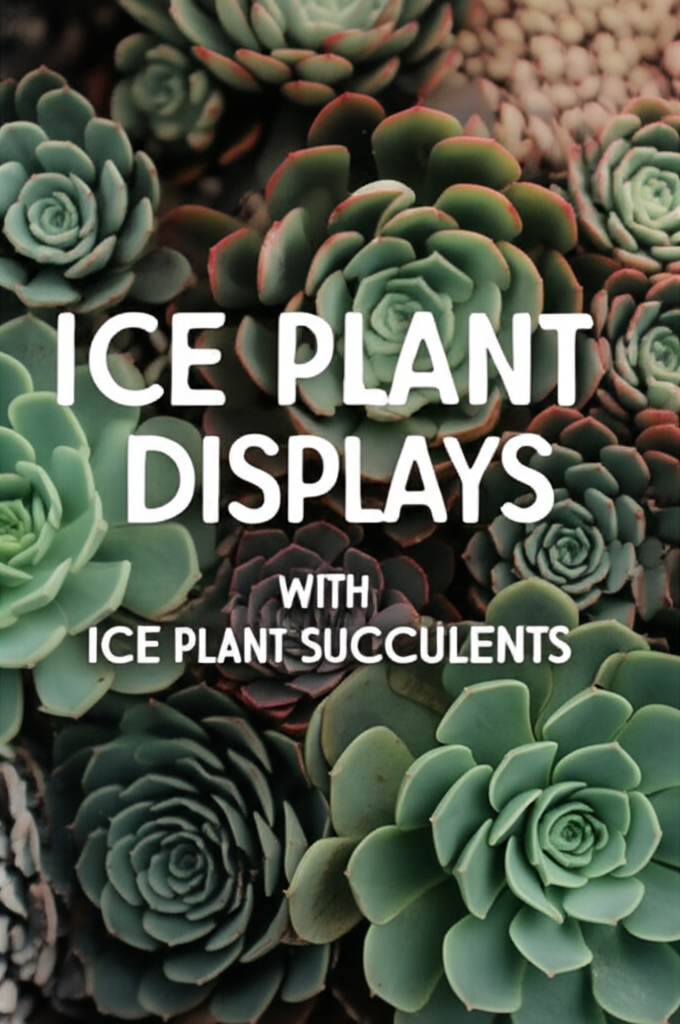Unveiling the Allure of Ice Plant Succulents
Ice plant succulents, members of the Mesembryanthemaceae family, are a horticultural delight. Known for their vibrant colors, unusual textures, and drought tolerance, they bring a unique charm to any space. Their common name, “ice plant,” refers to the glistening, bladder-like cells (papillae) covering their leaves, which refract light and give them a frosty appearance. From the sprawling groundcovers to the more compact, rosette-forming varieties, ice plants offer a dazzling array of forms and hues, making them incredibly versatile for creative display.
These fascinating succulents thrive in bright light and well-draining soil, mirroring their native habitats in arid regions of the world. Their resilience and low-maintenance nature make them ideal for both seasoned gardeners and beginners looking to add a touch of the extraordinary to their plant collections. This article will explore a wealth of creative display ideas, transforming these living jewels into captivating focal points in your home and garden.
Understanding Ice Plant Varieties for Display
Before diving into display ideas, it’s helpful to understand the diversity within the ice plant family. This will inform your choices based on size, growth habit, and desired aesthetic.
- Delosperma: Often referred to as the “hardy ice plant,” these varieties are known for their bright, daisy-like flowers and are more tolerant of cooler temperatures. They typically form low-growing mats.
- Lampranthus: Characterized by a profusion of vibrant, star-shaped flowers in shades of pink, purple, orange, and yellow. They tend to be more shrub-like.
- Conophytum: Also known as “living pebbles” or “button plants,” these are miniature, highly specialized succulents with fused leaf pairs. They offer incredible geometric beauty.
- Lithops: “Living stones,” these are masters of camouflage, resembling pebbles or stones in their natural environment. Their unique appearance is a conversation starter.
- Mesembryanthemum: The namesake genus, often featuring silvery foliage and large, showy flowers that open in sunlight.
Key Facts and Comparison for Display Planning
To effectively plan your ice plant displays, consider these key characteristics:
| Attribute | Delosperma (Hardy Ice Plant) | Lampranthus | Conophytum (Living Pebbles) | Lithops (Living Stones) |
|---|---|---|---|---|
| Growth Habit | Low-growing, spreading mat | Shrub-like, mounding | Clustering, miniature rosettes | Solitary or small clusters of fused leaves |
| Flower Appearance | Daisy-like, often brightly colored | Large, star-shaped, profuse blooms | Small, often star-shaped, bloom from fissure | Large, daisy-like, bloom from fissure |
| Hardiness | Generally hardy to USDA Zone 5/6 | More sensitive to frost, typically Zone 9+ | Varies, many are frost-sensitive | Varies, generally frost-sensitive |
| Light Requirements | Full sun | Full sun | Bright, indirect to direct light | Bright light, can scorch in intense direct sun |
| Watering Needs | Drought tolerant, allow soil to dry completely | Drought tolerant, allow soil to dry completely | Very little, allow soil to dry completely, dormant periods | Very little, allow soil to dry completely, dormant periods |
| Ideal Display Use | Rock gardens, ground cover, hanging baskets | Containers, borders, rock gardens | Miniature gardens, terrariums, small pots | Miniature gardens, terrariums, small pots |
Creative Display Ideas for Indoor Ice Plants

Bringing the unique beauty of ice plants indoors offers a fantastic way to brighten your living spaces. Their low water needs and tolerance for bright windowsills make them perfect houseplants.
Miniature Landscapes and Terrariums
The small size and captivating forms of Conophytum and Lithops make them ideal for creating miniature desert landscapes or closed terrariums.
- Desert Dioramas: Use shallow, wide containers like vintage tins, ceramic bowls, or clear glass dishes. Layer gravel, coarse sand, and a well-draining succulent mix. Arrange your tiny ice plants, interspersed with small stones, driftwood, and dried moss, to create a charming desert scene.
- Closed Terrarium Charm: While many succulents prefer open environments, some smaller, more compact ice plants can thrive in partially closed terrariums with good air circulation. Use a mix of sand, grit, and a well-draining soil. Ensure adequate drainage layers and avoid overwatering.
- Faux Desert Accents: For a low-maintenance decorative piece, arrange a collection of Lithops or Conophytum in small pots within a larger decorative bowl filled with sand and decorative pebbles. This creates a striking, sculptural display.
Hanging Baskets and Wall Planters
Certain ice plant varieties, particularly trailing or mat-forming types, are perfect for hanging baskets or vertical wall planters.
- Cascading Delights: Delosperma varieties with a trailing habit can create a beautiful cascading effect in hanging baskets. Choose a well-draining potting mix and ensure the basket receives ample sunlight.
- Vertical Gardens: Wall planters designed for succulents are an excellent way to showcase ice plants. Mix different colors and textures for a dynamic living wall. Ensure the planter has good drainage to prevent root rot.
- Repurposed Containers: Old birdcages, macrame hangers, or even colanders can be transformed into unique hanging planters for your ice plants, adding a rustic or bohemian touch.
Tabletop Vignettes and Collections
Groupings of ice plants in various containers can create stunning tabletop displays, adding life and color to desks, side tables, and shelves.
- Mixed Pot Collections: Combine several ice plants in different pot sizes and styles (e.g., terracotta, ceramic, concrete) on a tray or a decorative shelf. Vary the heights and textures for visual interest.
- Themed Displays: Create seasonal or thematic displays. For instance, a “winter wonderland” could feature ice plants with silvery or white papillae alongside small white pebbles and frosted branches.
- Single Specimen Focus: Sometimes, a single, exceptionally striking ice plant, like a particularly vibrant Lampranthus or a perfectly formed Lithops, deserves its own spotlight in a beautiful pot.
Creative Display Ideas for Outdoor Ice Plants
The vibrant colors and drought tolerance of ice plants make them superb additions to outdoor gardens, rockeries, and containers.
Rock Gardens and Alpine Scapes
Many ice plants, especially Delosperma, are naturally adapted to rocky, well-drained environments, making them perfect for rock gardens.
- Natural Integration: Place ice plants amongst rocks and gravel, mimicking their natural habitat. The rocks will help retain some moisture and heat, benefiting the plants.
- Color Bursts: Use brightly flowering Delosperma or Lampranthus varieties to create pops of color among the neutral tones of rocks and gravel.
- Creeping Groundcover: Allow spreading Delosperma varieties to naturalize between stepping stones or along pathways, creating a living carpet of color.
Container Gardening Excellence
Ice plants are exceptionally well-suited for container gardening, allowing you to control their environment and showcase them in various settings.
- Borders and Edging: Low-growing ice plants can effectively edge flower beds or pathways, providing a continuous display of color and texture.
- Patio and Balcony Displays: Group pots of ice plants together on patios or balconies for a striking visual impact. Mix and match different species for a diverse collection.
- Window Boxes: Brighten window boxes with a selection of ice plants, ensuring they receive ample sunlight and are planted in a well-draining soil mix.
- Mixed Planters: Combine ice plants with other drought-tolerant succulents, cacti, or ornamental grasses in larger containers for a multi-textured and visually dynamic arrangement.
Coastal and Xeriscape Gardens
Their salt tolerance and drought resistance make ice plants ideal for coastal gardens or any xeriscape design focused on water conservation.
- Drought-Tolerant Zones: Incorporate ice plants into areas of your garden that receive minimal water. They will thrive where other plants might struggle.
- Coastal Charm: Their ability to withstand salty air makes them a fantastic choice for seaside gardens, adding a splash of color against the backdrop of the ocean.
Steps for Creating Stunning Ice Plant Displays
Here’s a breakdown of the process for creating your own beautiful ice plant displays:
| Step | Description |
|---|---|
| 1. Choose Your Plants | Select ice plant varieties based on your desired display location, light conditions, and aesthetic preferences (e.g., trailing, compact, flowering). |
| 2. Select Containers/Location | Choose pots, baskets, or garden spaces that offer excellent drainage. Consider the size and growth habit of the plants when selecting. |
| 3. Prepare the Growing Medium | Use a well-draining succulent or cactus potting mix. You can enhance drainage by adding perlite, pumice, or coarse sand. For outdoor displays, amend heavy garden soil with grit. |
| 4. Planting | Gently remove plants from nursery pots. Place them in their new containers or garden spots, ensuring the base of the plant is at soil level. Avoid planting too deep. |
| 5. Watering | Water thoroughly after planting. For established plants, allow the soil to dry out completely between waterings. Overwatering is the most common cause of ice plant demise. |
| 6. Placement and Light | Position indoor plants in the brightest possible location, typically a south-facing window. Outdoor plants should receive adequate sunlight as per their specific needs. |
| 7. Ongoing Care and Maintenance | Monitor for pests, prune as needed to maintain shape, and fertilize sparingly during the growing season with a diluted succulent fertilizer. Adjust watering based on environmental conditions. |
Pros and Cons of Ice Plant Displays
While ice plants offer numerous advantages for display, it’s also wise to consider potential drawbacks.
| Pros | Cons |
|---|---|
| Drought Tolerance: Require minimal watering, making them excellent for water-wise gardening and busy individuals. | Frost Sensitivity: Many varieties are not frost-hardy and will need protection or to be brought indoors during cold weather. |
| Vibrant Colors: Offer a spectacular range of flower colors and leaf hues that can transform any display. | Drainage is Crucial: Imperfect drainage can quickly lead to root rot, a common problem for succulents. |
| Low Maintenance: Generally require little fuss once established, aside from appropriate watering and light. | Pest Vulnerability: Can occasionally be susceptible to mealybugs or aphids, though generally quite resistant. |
| Unique Textures: The papillae provide a distinctive visual and tactile interest not found in many other plants. | Light Requirements: Many varieties need full sun to thrive and bloom profusely, which may limit placement options indoors. |
| Versatile Growth Habits: From groundcovers to compact rosettes, there’s an ice plant suitable for almost any display type. | Overwatering Risk: Their succulent nature means they store water in their leaves, making them very susceptible to rot from overwatering. |
Conclusion: Elevating Your Space with Ice Plant Creativity
Ice plant succulents offer an extraordinary palette for creative expression, whether you’re designing a miniature desert scape indoors or a vibrant rock garden outdoors. Their unique textures, dazzling floral displays, and remarkable resilience make them a rewarding choice for any plant enthusiast. By understanding the diverse characteristics of different ice plant varieties and employing thoughtful display techniques, you can transform these mesmerizing mesembs into captivating focal points that bring enduring beauty and a touch of the exotic to your surroundings. Embrace the frost-kissed allure of ice plants and let your creativity bloom!


